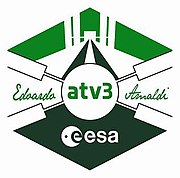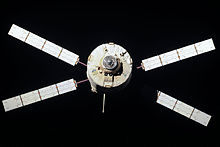
The Progress is a Russian expendable cargo spacecraft. Its purpose is to deliver the supplies needed to sustain a human presence in orbit. While it does not carry a crew, it can be boarded by astronauts when docked to a space station, hence it is classified as crewed by its manufacturer. Progress is derived from the crewed Soyuz spacecraft and launches on the same launch vehicle, a Soyuz rocket.

The Automated Transfer Vehicle, originally Ariane Transfer Vehicle or ATV, was an expendable cargo spacecraft developed by the European Space Agency (ESA), used for space cargo transport in 2008–2015. The ATV design was launched to orbit five times, exclusively by the Ariane 5 heavy-lift launch vehicle. It effectively was a larger European counterpart to the Russian Progress cargo spacecraft for carrying upmass to a single destination—the International Space Station (ISS)—but with three times the capacity.
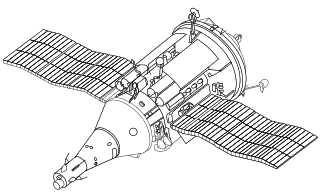
The TKS spacecraft was a Soviet spacecraft conceived in the late 1960s for resupply flights to the military Almaz space station.

Uncrewed spaceflights to the International Space Station (ISS) are made primarily to deliver cargo, however several Russian modules have also docked to the outpost following uncrewed launches. Resupply missions typically use the Russian Progress spacecraft, European Automated Transfer Vehicles, Japanese Kounotori vehicles, and the American Dragon and Cygnus spacecraft. The primary docking system for Progress spacecraft is the automated Kurs system, with the manual TORU system as a backup. ATVs also use Kurs, however they are not equipped with TORU. The other spacecraft — the Japanese HTV, the SpaceX Dragon and the Northrop Grumman Cygnus — rendezvous with the station before being grappled using Canadarm2 and berthed at the nadir port of the Harmony or Unity module for one to two months. Progress, Cygnus and ATV can remain docked for up to six months. Under CRS phase 2, Cargo Dragon docks autonomously at IDA-2 or 3 as the case may be. As of December 2022, Progress spacecraft have flown most of the uncrewed missions to the ISS.

The Jules Verne ATV, or Automated Transfer Vehicle 001 (ATV-001), was a robotic cargo spacecraft launched by the European Space Agency (ESA). The ATV was named after the 19th-century French science-fiction author Jules Verne. It was launched on 9 March 2008 on a mission to supply the International Space Station (ISS) with propellant, water, air, and dry cargo. Jules Verne was the first of five ATVs to be launched.

The International Space Station programme is tied together by a complex set of legal, political and financial agreements between the fifteen nations involved in the project, governing ownership of the various components, rights to crewing and utilisation, and responsibilities for crew rotation and resupply of the International Space Station. It was conceived in September 1993 by the United States and Russia after 1980s plans for separate American (Freedom) and Soviet (Mir-2) space stations failed due to budgetary reasons. These agreements tie together the five space agencies and their respective International Space Station programmes and govern how they interact with each other on a daily basis to maintain station operations, from traffic control of spacecraft to and from the station, to utilisation of space and crew time. In March 2010, the International Space Station Program Managers from each of the five partner agencies were presented with Aviation Week's Laureate Award in the Space category, and the ISS programme was awarded the 2009 Collier Trophy.

The Johannes Kepler ATV, or Automated Transfer Vehicle 002 (ATV-002), was an uncrewed cargo spacecraft built to resupply the International Space Station (ISS). It was launched on February 16, 2011 by the European Space Agency (ESA). Johannes Kepler carried propellant, air and dry cargo weighing over 7,000 kilograms (15,000 lb), and had a total mass of over 20,000 kilograms (44,000 lb), making it, at the time, the heaviest payload launched by the ESA. The spacecraft was named after the 17th-century German astronomer Johannes Kepler.
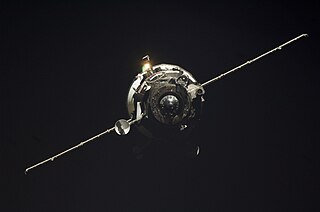
Progress M-65, identified by NASA as Progress 30P, was a Progress spacecraft used to resupply the International Space Station. It was a Progress-M 11F615A55 spacecraft, with the serial number 365.

Progress M1-11, identified by NASA as Progress 13P, was a Progress spacecraft used to resupply the International Space Station. It was a Progress-M1 11F615A55 spacecraft, with the serial number 260.

Expedition 30 was the 30th long-duration mission to the International Space Station (ISS). The expedition's first three crew members – Dan Burbank, Anton Shkaplerov and Anatoli Ivanishin – arrived on the ISS aboard Soyuz TMA-22 on 16 November 2011, during the last phase of Expedition 29. Expedition 30 formally began on 21 November 2011, with the departure from the ISS of the Soyuz TMA-02M spacecraft. The expedition ended on 27 April 2012, as Burbank, Shkaplerov and Ivanishin departed from the ISS aboard Soyuz TMA-22, marking the beginning of Expedition 31.

Progress M-04M, identified by NASA as Progress 36P, was a Russian Progress spacecraft launched in February 2010 to resupply the International Space Station. It was docked with the aft port of the Zvezda module of the station.

Progress M-07M, identified by NASA as Progress 39P, is a Progress spacecraft which was used to resupply the International Space Station. It was the seventh Progress-M 11F615A60 spacecraft to be launched, the fourth for the year 2010 and has the serial number 407. The spacecraft was manufactured by RKK Energia, and is being operated by the Russian Federal Space Agency. It arrived at the space station whilst the Expedition 24 crew was aboard, and will remain docked for the entirety of Expedition 25, before departing during Expedition 26.
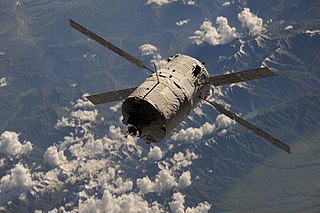
The Albert Einstein ATV, or Automated Transfer Vehicle 004 (ATV-004), was a European uncrewed cargo resupply spacecraft, named after the German-born physicist Albert Einstein. It was built to supply the International Space Station (ISS) with propellant, water, air, and dry cargo, and also to reboost the station's altitude with its thrusters. It was the fourth and penultimate ATV to be built, following the Edoardo Amaldi, which was launched in March 2012. Albert Einstein's components were constructed in Turin, Italy, and Bremen, Germany, and underwent final assembly and testing in Bremen in 2012. The spacecraft left Bremen for Kourou on 31 August 2012 to begin launch preparations.

The Georges Lemaître ATV, or Automated Transfer Vehicle 5 (ATV-5), was a European uncrewed cargo spacecraft, named after the Belgian astronomer Georges Lemaître. The spacecraft was launched during the night of 29 July 2014, on a mission to supply the International Space Station (ISS) with propellant, water, air, and dry cargo. It was the fifth and final ATV to be built and launched. Georges Lemaître was constructed in Turin, Italy, and Bremen, Germany. Cargo loading was completed in Guiana Space Center on 23 July 2014.

The European contribution to the International Space Station comes from 10 members of the European Space Agency (ESA) and amounts to an 8% share in the programme. It consists of a number of modules in the US Orbital Segment, ATV supply ships, launchers, software and €8 billion.

Progress M-19M, identified by NASA as Progress 51P, is a Progress spacecraft used by Roskosmos to resupply the International Space Station during 2013. Progress M-19M was launched on a standard 2-day rendezvous profile towards the ISS. The 19th Progress-M 11F615A60 spacecraft to be launched, it had the serial number 419 and was built by RKK Energia.

Progress MS-10, identified by NASA as Progress 71P, was a Progress spaceflight operated by Roscosmos to resupply the International Space Station (ISS). This was the 162nd flight of a Progress spacecraft.
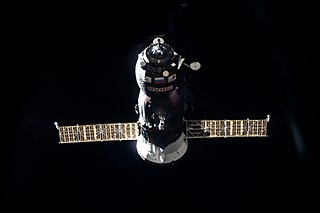
Progress MS-16, Russian production No. 445, identified by NASA as Progress 77P, was a Progress spaceflight operated by Roscosmos to resupply the International Space Station (ISS). This was the 168th flight of a Progress spacecraft.

